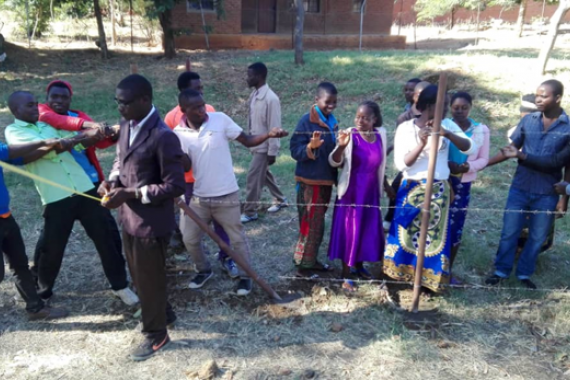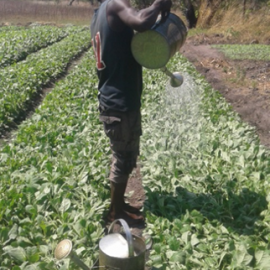Combatting Wildlife Crime in the Malawi-Zambia Landscape
Current initiative
Published

Training community members from Kasungu on construction skills. Photo by Jonathan Thorneycroft
This initiative supports the Governments of Malawi and Zambia in reducing IWT and poaching and improving transboundary wildlife management in the Malawi-Zambia landscape.
Project activities are focused on strengthening and/or improving engagement of communities by changing behaviour, establishing an anti-poaching unit, the development of alternative livelihoods and more.
This case study focuses only on Community Engagement activities.
Lead

Location
Malawi (focus on Kasungu National Park) and Zambia (focus on Lukusuzi and Luambe National Parks)
The poaching and wildlife trade problem
Species affected African Elephant Loxodonta africana , Black Rhino Diceros bicornis , Leopard Panthera pardus , Lion Panthera leo , Temminck's Ground Pangolin Smutsia temminckii
The anti-IWT initiative
The overall goal of the program is supporting the Governments of Malawi and Zambia in reducing illegal wildlife trade and poaching and improving transboundary wildlife management in the Malawi-Zambia landscape.
Imani’s activities are focused on strengthening and/or improving engagement of communities towards this aim in both Malawi and Zambia.
Malawi
In Kasungu National Park (NP) the intervention logic we are applying is to take a holistic approach with three key elements working together towards reducing poaching and trafficking:
- Behavioural change campaign (from Lilongwe Wildlife Trust) to ensure communities are a) informed of the value of wildlife and ecosystem services
b) fully aware of what is illegal under the current wildlife crime legislation in Malawi and what the penalties are for poaching and trafficking and
c) taking responsibility to providing information to protect wildlife.
- The establishment of an effective anti-poaching unit (from IFAW) to ensure that there is effective control on poaching and that poachers will be caught and prosecuted. This includes providing incentives for the community to report wildlife crime as part of the community enforcement network (which is already having very positive results in terms of number of crimes reported).
- Community engagement/livelihood initiatives (led by Imani) that offer opportunities for community members to address key challenges (e.g. tsetse flies, access to markets) while at the same time providing livelihood opportunities which are linked to the park. In the short term this is about income generation but in the longer term this is helping to challenge perceptions.
As part of our evidence-based approach Imani has completed a detailed community needs assessment (based on both qualitative and quantitative data) which then informed a feasibility study to identify potential suitable livelihood interventions for local communities around Kasungu NP. As a result, four viable livelihood interventions have been identified, with two being selected (namely tsetse trap and agriculture market linking) as the most suitable for piloting. The aim of these interventions is about changing perceptions of the wider community about wildlife, not about directly converting poachers. In Kasungu this means helping people to start to see the wildlife and Park itself as something worth conserving, not just got the sake of conservation but because they see a (sustainable) benefit for themselves too, which helps to meet some of their needs.
Zambia
In Zambia we are currently in the process of designing the interventions, based on data and evidence we have obtained from needs assessments for communities in Lukusuzi and Luambe NPs in Zambia, which will be analysed and followed by a feasibility study of the potential livelihood interventions. Given the difference in conservation management strategy (i.e. use of Game Management Areas, rather than ‘hard’ fences) and differences in landscape and community structure, it is envisaged that a very different approach will be required on community engagement and livelihood interventions. This strategy will be developed, informed by discussion with all partners and key stakeholders.
Initial discussions are exploring how conservation science data on elephant movements and behaviour can be used to identify areas and strategies where community could be engaged in activities to protect, or even restore, habitat critical for important wildlife corridors between Malawi and Zambia.
We are also exploring how wildlife crime and trafficking data, from local partners Wildlife Crime Prevention (WCP), can be used to identify ‘hotspots’ of illegal wildlife activity, which could be targeted in the community engagement strategy. WCP also have an active community awareness element, which includes a radio programme aimed at informing the communities of the penalties for wildlife crime and trafficking and challenging common perceptions of poaching, wildlife and Parks authorities.
The strategy
Strengthening disincentives for illegal behaviour
This is mainly through the work of IFAW and Kasungu NP in terms of their community intelligence work, and also Lilongwe Wildlife Trust (LWT) and Wildlife Crime Prevention (WCP) in terms of raising awareness about wildlife crime penalties.
Decreasing the costs of living with wildlife
The tsetse trap intervention will create a physical boundary along the edge of the Park aimed at deterring communities entering it or grazing their cattle inside the park.
Tsetse flies are abundant in the Kasungu area and they act as disease carriers transmitting sleeping sickness to humans and nagana (animal trypanosomiasis) to cattle/livestock. Tsetse flies need shade, so they are found in areas with a great deal of tree and vegetation cover, often in protected areas that have not been significantly affected by high levels of deforestation. The tsetse trap intervention attempts to drive away tsetse flies from the target area through a combination of insecticides, colour signalling, and appropriate trap placement. As discussed with the community representatives, the traps will be set up in 1km intervals and monitored by trained community members. These traps will be the colour blue, as it has been found that tsetse flies are attracted to this colour.
A year’s supply of cloth and insecticide will be purchased, and this intervention will be linked to the tailoring team within the park to manufacture the traps on a sustainable basis. This will also connect the tsetse trap management with the Park operation.
Increasing livelihoods that are not related to wildlife
Currently, the rations for rangers who patrol Kasungu NP and other park staff are purchased from the Kasungu Boma (market). An alternative is to allow small holder farmers to sell their produce directly to the Park without traveling long distances for markets. In order to direct this market, deep ties will have to be developed between the park and specific small holder farmers, such that they will be able to trust selling their produce directly to the park community. Imani will employ a coordinator who will reach out to selected smallholders and connect them with the park management to develop a sustained business relationship. The team will also coordinate directly with the government extension workers assigned to the area to provide technical assistance to the farmers to be able to supply agricultural products needed by the Park on a regular basis.
As part of a strategy to engage with the wider community Imani will also conduct trainings on viable vocational and business skills for a section of the community, aimed at improving skills for future employment opportunities. These trainings will particularly target unemployed women and youth and be linked to real opportunities for employment.
Build/and or support sense of community ownership or stewardship
Further detailThe community will manage the tsetse trap intervention, which will create a physical boundary along the edge of the Park aimed at deterring communities entering it or grazing their cattle inside the park.
Improving education and awareness
Further detailLWT and WCP are running campaigns, in Malawi and Zambia respectively, to ensure communities are fully aware of what is illegal under the current wildlife crime legislation in Malawi and what the penalties are for poaching and trafficking.
Organisers, donors and partners
The Combatting Wildlife Crime in the Malawi-Zambia Landscape (CWC-MAZALA) program, is a five-year USAID-funded program (Oct 2017-Sep 2022).
Please note: The program lead is the International Fund for Animal Welfare (IFAW), who also lead on all the on-the-ground enforcement work in Malawi. The following partners/sub-awardees are also involved:
Imani Development – focus is community engagement in Malawi and Zambia
Wildlife Crime Prevention (WCP) – focus is wildlife crime in Zambia
Lilongwe Wildlife Trust (LWT) – focus is wildlife crime in Malawi
For further information contact Keith Bohannon (keithb@imanidevelopment.com).


